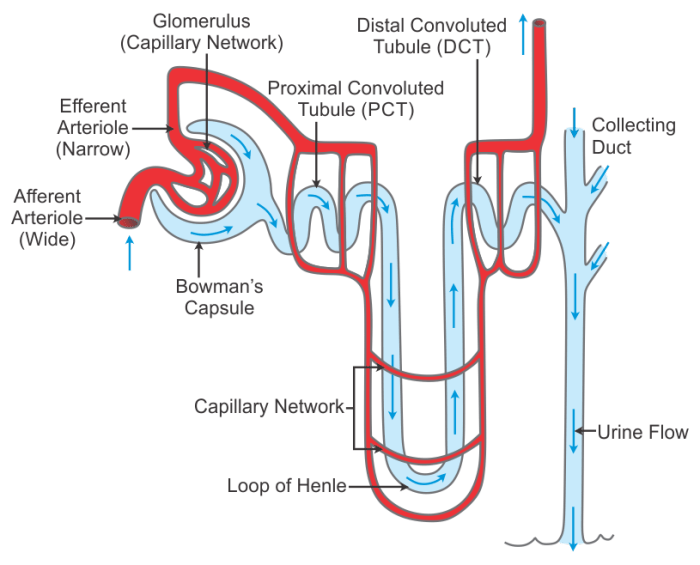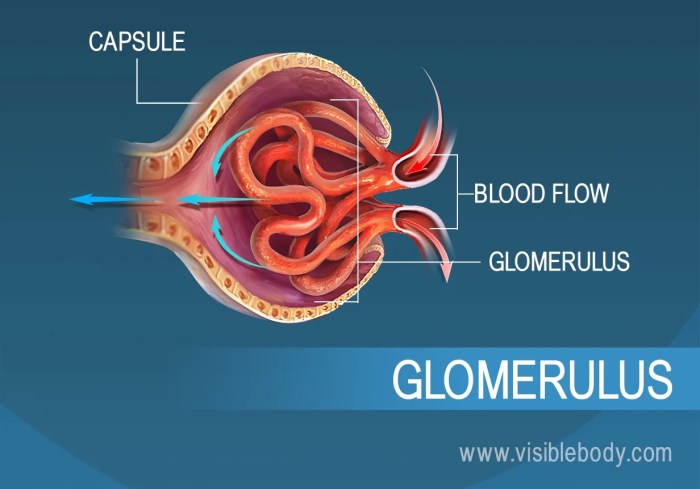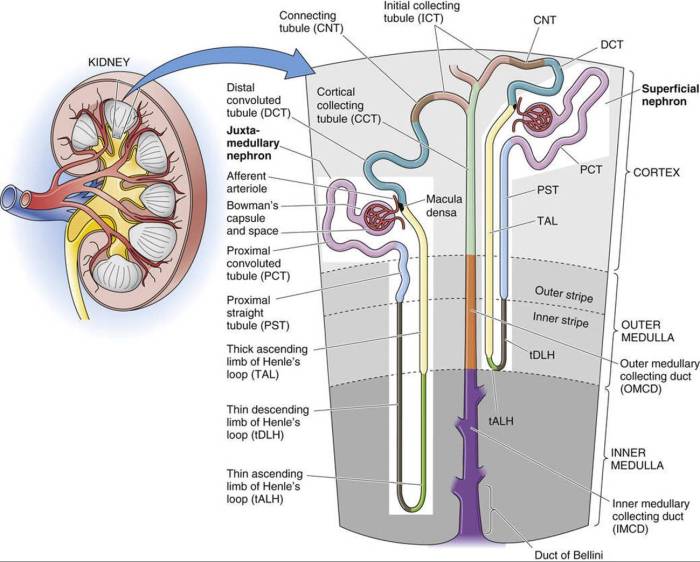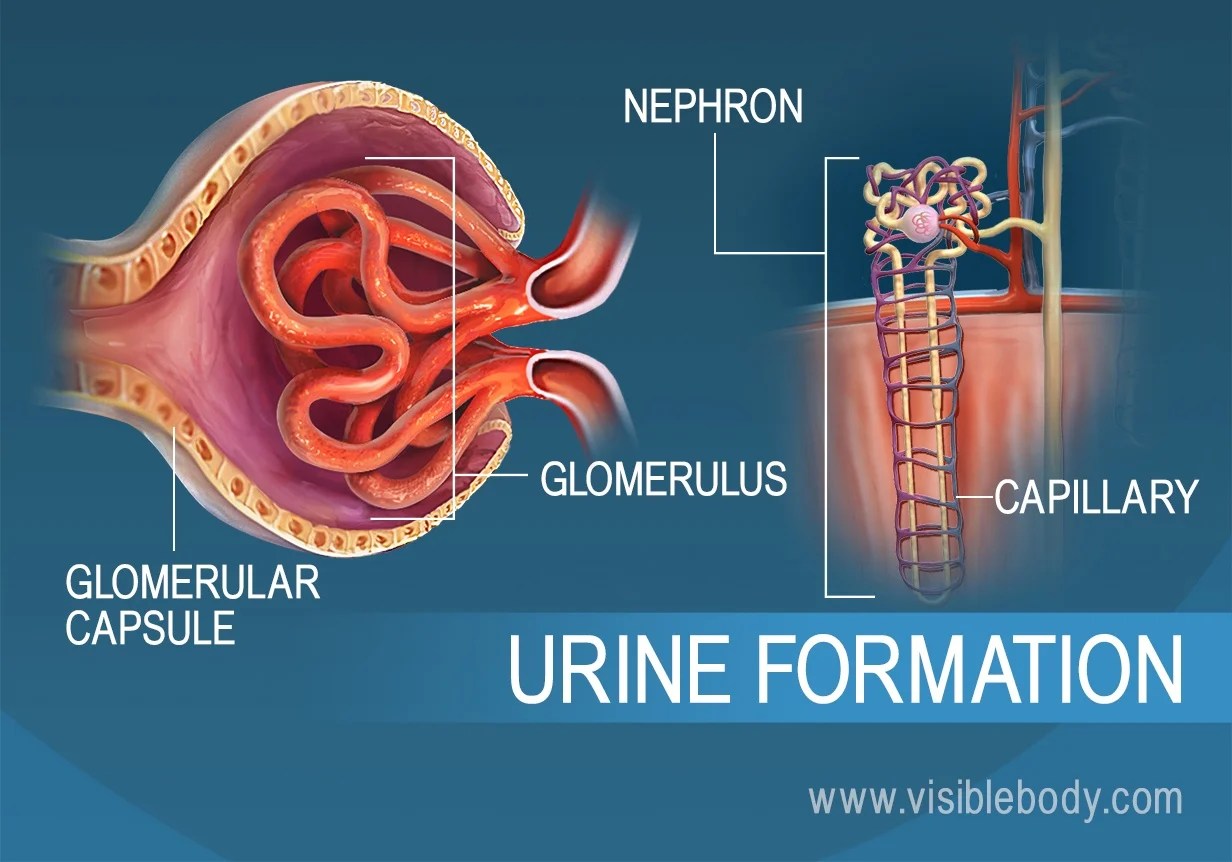Match each of the following renal structures with their functions – Delving into the intricate world of renal physiology, we embark on a journey to unravel the functions of the various renal structures. From the glomerulus, the gatekeeper of filtration, to the collecting duct, the fine-tuner of water balance, each component plays a crucial role in maintaining homeostasis and ensuring the optimal functioning of the urinary system.
Renal Structures and their Functions: Match Each Of The Following Renal Structures With Their Functions

The kidneys play a vital role in maintaining homeostasis by filtering waste products from the blood and producing urine. The renal structures involved in this process include the glomerulus, proximal convoluted tubule (PCT), loop of Henle, distal convoluted tubule (DCT), collecting duct, renal pelvis, ureter, urinary bladder, and urethra.
Glomerulus
The glomerulus is a network of tiny blood vessels located in the renal corpuscle. It is responsible for filtering waste products from the blood into the Bowman’s capsule, the initial part of the nephron.
- Role in filtration:The glomerulus filters waste products, such as urea, creatinine, and excess ions, from the blood into the Bowman’s capsule.
- Structure:The glomerulus consists of a tuft of capillaries surrounded by a Bowman’s capsule. The capillaries are lined with podocytes, which have foot processes that interdigitate to form filtration slits.
- Functions of the glomerular basement membrane:The glomerular basement membrane (GBM) is a thin layer of extracellular matrix that separates the capillaries from the Bowman’s capsule. It acts as a barrier to prevent large molecules, such as proteins, from being filtered into the urine.
Proximal Convoluted Tubule (PCT)
The PCT is the first part of the renal tubule after the Bowman’s capsule. It is responsible for reabsorbing essential nutrients and water from the filtrate.
- Reabsorption and secretion processes:The PCT reabsorbs glucose, amino acids, vitamins, and electrolytes, such as sodium, potassium, and chloride, from the filtrate. It also secretes hydrogen ions and organic acids into the filtrate.
- Role in glucose reabsorption:The PCT reabsorbs approximately 99% of the glucose filtered by the glomerulus. This is achieved through the action of sodium-glucose cotransporters, which transport glucose and sodium ions across the tubular epithelium.
- Importance in maintaining electrolyte balance:The PCT plays a crucial role in maintaining electrolyte balance by reabsorbing essential ions, such as sodium, potassium, and chloride, from the filtrate.
Loop of Henle
The loop of Henle is a U-shaped structure that descends into the medulla of the kidney and then ascends back towards the cortex. It is responsible for creating a concentration gradient in the medulla, which is essential for water reabsorption.
- Descending and ascending limbs:The descending limb of the loop of Henle is permeable to water but impermeable to sodium ions. The ascending limb is impermeable to water but permeable to sodium ions.
- Role in creating a concentration gradient:The descending limb of the loop of Henle allows water to diffuse out of the filtrate into the medulla, creating a higher concentration of sodium ions in the medulla. The ascending limb actively transports sodium ions out of the filtrate into the medulla, further increasing the concentration gradient.
- Importance in water reabsorption:The concentration gradient created by the loop of Henle allows water to be reabsorbed from the filtrate in the collecting duct.
Distal Convoluted Tubule (DCT)
The DCT is the final part of the renal tubule before the collecting duct. It is responsible for fine-tuning the composition of the urine by reabsorbing and secreting ions.
- Reabsorption and secretion processes:The DCT reabsorbs sodium ions and secretes potassium ions and hydrogen ions into the filtrate.
- Role in sodium reabsorption:The DCT reabsorbs approximately 5% of the filtered sodium ions. This is achieved through the action of sodium-potassium pumps, which transport sodium ions out of the filtrate into the tubular epithelium.
- Importance in potassium secretion:The DCT plays a crucial role in regulating potassium balance by secreting excess potassium ions into the filtrate.
Collecting Duct
The collecting duct is the final part of the nephron. It is responsible for collecting urine from the distal convoluted tubules and modifying its composition.
- Structure and function:The collecting duct is a long, narrow tube that runs from the DCT to the renal pelvis. It is lined with principal cells and intercalated cells, which are responsible for regulating water and electrolyte reabsorption.
- Role in water reabsorption:The collecting duct reabsorbs water from the filtrate under the influence of antidiuretic hormone (ADH). ADH increases the permeability of the collecting duct to water, allowing it to diffuse out of the filtrate and into the medulla.
- Importance in regulating blood pressure:The collecting duct plays a role in regulating blood pressure by reabsorbing sodium ions. Sodium reabsorption increases the osmotic pressure of the filtrate, which draws water out of the blood vessels and into the collecting duct. This increases blood volume and blood pressure.
Renal Pelvis
The renal pelvis is a funnel-shaped structure that collects urine from the calyces of the kidney. It is the initial part of the urinary tract.
- Structure and function:The renal pelvis is lined with transitional epithelium and contains smooth muscle cells that help to propel urine into the ureter.
- Role in collecting urine:The renal pelvis collects urine from the calyces and directs it into the ureter.
- Importance in preventing urinary tract infections:The renal pelvis contains immune cells that help to prevent urinary tract infections.
Ureter
The ureter is a muscular tube that transports urine from the renal pelvis to the urinary bladder. It is lined with transitional epithelium and contains smooth muscle cells that help to propel urine.
- Structure and function:The ureter is a long, narrow tube that runs from the renal pelvis to the urinary bladder. It is lined with transitional epithelium and contains smooth muscle cells that help to propel urine.
- Role in transporting urine:The ureter transports urine from the renal pelvis to the urinary bladder by means of peristaltic contractions.
- Importance in preventing urinary tract infections:The ureter contains immune cells that help to prevent urinary tract infections.
Urinary Bladder
The urinary bladder is a muscular sac that stores urine until it is released through the urethra. It is lined with transitional epithelium and contains smooth muscle cells that help to expel urine.
- Structure and function:The urinary bladder is a hollow, muscular organ that stores urine. It is lined with transitional epithelium and contains smooth muscle cells that help to expel urine.
- Role in storing urine:The urinary bladder stores urine until it is released through the urethra.
- Importance in controlling urination:The urinary bladder controls urination by contracting its smooth muscle cells and opening the internal urethral sphincter.
Urethra, Match each of the following renal structures with their functions
The urethra is a tube that transports urine from the urinary bladder to the outside of the body. It is lined with transitional epithelium and contains smooth muscle cells that help to propel urine.
- Structure and function:The urethra is a short, narrow tube that runs from the urinary bladder to the outside of the body. It is lined with transitional epithelium and contains smooth muscle cells that help to propel urine.
- Role in transporting urine:The urethra transports urine from the urinary bladder to the outside of the body.
- Importance in preventing urinary tract infections:The urethra contains immune cells that help to prevent urinary tract infections.
FAQ Overview
What is the primary function of the glomerulus?
The glomerulus is responsible for filtering blood and initiating the formation of urine.
How does the proximal convoluted tubule contribute to electrolyte balance?
The PCT plays a vital role in reabsorbing essential electrolytes, such as sodium and potassium, helping to maintain their proper levels in the body.
What is the significance of the loop of Henle in water reabsorption?
The loop of Henle creates a concentration gradient in the kidney, facilitating the reabsorption of water from the tubular fluid.


